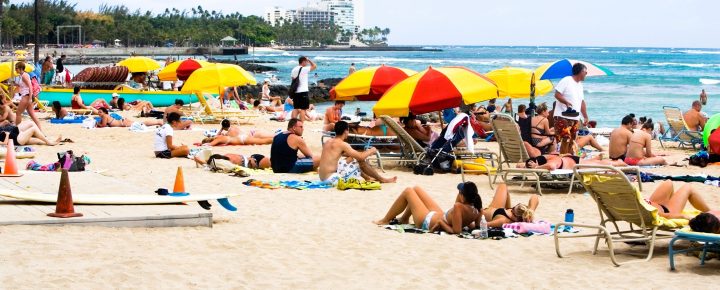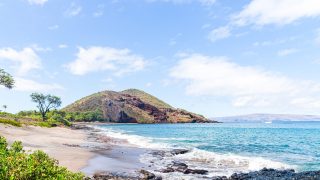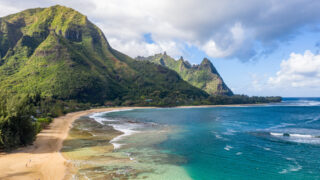Hawaii is clearly beginning what will become a huge transformation in its tourism approach, signaling the end of an era that for six decades was dominated by more hotels, visitors, and construction projects. The islands have long-faced challenges because of what happened, as seen in overtourism that impacts both the environment and the resident population.
As a U.S. state with open borders yet with limited infrastructure and questionable wherewithal, Hawaii remains hard-pressed to know exactly what to do about overtourism.
The shift toward a more sustainable and regenerative tourism model is underway.
Buzzwords, inspired by global trends, are seen in other iconic destinations like those below. These destinations have all focused on creating a more harmonious relationship between visitors and residents, emphasizing responsibility and shared benefits.
Last month, Hawaii Governor Green began tackling pressing issues that will significantly impact Hawaii visitors. One key proposal involves a potential moratorium on Maui vacation rentals by March, aiming to convert around 10% of the existing 27,000 short-term rental units into long-term rentals for Lahaina fire victims.
The governor is determined to implement his climate impact fee.
He is now proposing a $25 fee on hotel or short-term rental check-ins, that would generate $68 million annually for beach preservation and fire prevention. If that doesn’t pass, Green will move towards raising the 18% accommodation tax for hotels and vacation rentals even further.
The complex interplay of these proposals and others that will be forthcoming reflects the ongoing challenges in Hawaii’s visitor, economic, and housing landscapes.
Yesterday’s visitor growth plans have evolved into a visitor value model.
As much as visitors don’t want to hear it, the moves afoot do involve prioritizing quality experiences for both Hawaii visitors and residents over visitor growth. That equates to the high cost of Hawaii vacations persisting.
Efforts to retain and value repeat visitors, however, are still emphasized by some, recognizing their contribution to Hawaii’s tourism legacy. While Hawaii has long been blessed with a high rate of return visitors who require no marketing, it isn’t clear if that trend will continue.
As the islands navigate this journey of transformation, the goal is to embrace sustainable practices and improve the tourist experience while creating a more positive impact on Hawaii communities and the environment.
However, challenges such as the perception of anti-visitor sentiment, which in part stems from overtourism, remain on the agenda without clear-cut answers.
Hawaii doesn’t invest in tourism infrastructure.
There has been virtually nothing done to improve the basic infrastructure that is needed to support high-end, high-quality vacations. Lack of airport and road improvements and beach facilities are just a few of the most obvious examples of that which Hawaii sorely lacks. While rarely mentioned by state officials, this is a problem at odds with their desired high-value tourism model.
Overtourism isn’t Hawaii’s problem alone.
Some of the other iconic world destinations that are dealing with similar overtourism issues are places that Hawaii is watching. They include the following:
Palau.
The Problem: The 500-island nation in the Western Pacific and UNESCO World Heritage site attracts visitors seeking an idyllic tropical escape. But there isn’t enough Palau to go around. So now, their focus has turned to sustainability.
What’s being done: The country introduced the groundbreaking “Palau Pledge” as it faced the strain of an overwhelming surge in tourist numbers and its attempt to encourage responsible travel. Since then, many other global travel destinations have adopted similar approaches to managing overtourism and promoting ethical behavior among visitors. For years, every airline ticket into Palau has included a $100 “Pristine Paradise” green fee.
Amsterdam, Netherlands
The Problem: Over 21 million visitors in a city of fewer than one million residents.
What’s being done: Amsterdam is implementing new measures to preserve its identity and address visitor nuisances. Initiatives include banning cruise ships from the city center, discouraging certain demographics from coming and suggesting alternate, sustainable activities like cycling. Amsterdam’s goal, like Hawaii’s is finding a balance that ensures responsible tourism and benefits both locals and visitors.
Machu Picchu, Peru
The Problem: Over a million annual visitors causing damage to the UNESCO site.
What’s being done: Marked trails, capped daily entrants, and new nearby airport construction. Since 2019, Machu Picchu tourism has become more tightly regulated, and tourists must follow four circular paths on the Inca Trail.
Thailand’s Maya Bay
The Problem: Overcrowded beaches and islands are destroying the bay’s coral reef following years of boats coming in and anchoring.
What’s being done: Maya Bay in Thailand, once plagued by overtourism, witnessed a significant transformation after an environmental rejuvenation project. The bay was closed indefinitely in 2018 due to ecological degradation. It subsequently reopened with improved infrastructure and visitor management.
While closed, more than 30,000 coral pieces were replanted, resulting in revived marine life. Authorities have also implemented strict measures to limit daily visitor count as well as educational initiatives. The success at Maya Bay is considered a model for how to balance tourism and environmental preservation.
Prague, Czech Republic
The Problem: Impact on historic city center due to booming tourism.
What’s being done: “Putting Prague First” is the plan to manage tourism sustainably. Staying in traditional accommodations, avoiding short-term rentals, and traveling respectfully are recommended. Heavily tourism-reliant Prague has had visitors negatively impact residents’ quality of life.
The city’s Strategy for Sustainable Tourism aims to address these issues by balancing economic benefits with Prague’s strategic interests, emphasizing sustainability, residents’ well-being, and cultural preservation. The plan calls for a comprehensive approach involving various stakeholders, including Prague City Hall, City Districts, organizations, residents, and businesses, to maximize positive aspects and minimize the negatives associated with tourism.
Bhutan
The Problem: Low visitor numbers yet concerns about the environmental impact of tourism.
Solution: Bhutan reduced its daily “green” fee from $200 to $100, aiming to revitalize tourism, which is continuing to face challenges, including the fee. Bhutan previously raised its “Sustainable Development Fee” to $200 per night to offset carbon emissions generated by visitors. The government now hopes that the reduced fee, effective for the next four years, will help in generating employment, earning foreign exchange, and fostering overall economic growth.
Venice, Italy
The Problem: Overcrowding and environmental strain.
Solution: Ban on large cruise ships, ticketed timed entry experiment. Suggestions include avoiding popular spots and exploring alternative destinations like Burano and Caorle. Long-challenged by overtourism, tour groups in Venice will be restricted to 25 people, and the use of loudspeakers will be prohibited. Large cruise ships are being banned, and day visitors must obtain passes costing up to €10 per person. Failure to obtain a pass comes with up to a €300 fine. Overnight visitors don’t pay the daily fee as it is already calculated into lodging taxes and fees.
Note: Venice’s green fee is sounding very similar to what Gov. Green last proposed. These new fees are designed to help alleviate the strain of overtourism, but we aren’t clear on exactly how the money will be accounted for and appropriated.
Bali
The Problem: Behavioral issues, overcrowding, and traffic impacting local culture and environment.
Solution: Released “do’s and don’ts” about respect for local customs, behavior at religious sites, and acting responsibly. Bali proposes tourists go to less crowded areas like northern Bali (Buleleng and Karangasem), western Bali (Jembrana), and eastern Bali (Kelungkung). The aim is to diversify tourist options, helping alleviate overcrowding in Southern Bali. New traffic controls and other transport plans are coming to help ease traffic congestion that has long been bad. During the December holidays, five-hour traffic jams occurred heading to and from the airport.
Barcelona
The Problem: Strict licensing laws for short-term rentals, bans on smoking on beaches, and restrictions on night-time noise levels.
Solution: Barcelona has long grappled with overtourism but has now implemented measures to address the problem. The city recently reduced the number of cruise ships docking there from ten to seven. Barcelona also raised the tourist tax from €5.25 to €6.75 per night for guests staying in the best hotels. Suggestions for those heading to Barcelona include considering instead Valencia, another seaside town that’s well-renowned and hasn’t yet reached tourism saturation.
Please share your thoughts on Hawaii overtourism, its new high-value tourism model, and your future travel plans.
Get Breaking Hawaii Travel News







Update:
Maya Bay did close for awhile, and did have a daily limit, but not anymore. The place is still packed with a long line to see it, but the caveat is, you may only go in the water up to your knees. It is definetly not worth going to anymore.
*A person that lives near Maya Bay.
Aloha.
I went to Hawaii with my family in 2 years ago.
We go to Oahu from Portland Oregon to Seattle Washington,
And then Big Island from Oahu.
My family took me to to Polynesian Cultural Center in Oahu,
See luau, volcano national park, snorkel, swim with dolphins at Dolphin Quest in Kona. I look for what some of what Polynesian cultures and Native Hawaiians are.
We had fun times together.
I hadn’t been to Kauai, Maui, Molokai, Lanai, Kahoolawe, and Niihau yet.
I always feel go back to Hawaii.
I hope some places is better and new and fun again.
Aloha.🥰💋🤙🤙🤙🤙🤙
Tourists are not allowed to visit Kahoolawe or Niihau and Molokai doesn’t have any resort since the Sheraton closed many years ago. I believe there are some smaller hotels, but you will see a warning when you book some of them to make sure they are actually in compliance …that said, Kauai is beautiful, if you haven’t been there yet. I visited last Christmas (for the 1st time in 30 years), since I now live in Maui.
I have been traveling to Hawaii for ten years now, I Love that it is our country,I have traveled a lot of the US and Hawaii isy all American favorite destination, I have had Great experiences and bad one’s it’s what you make of it,cost is crazy here and I might add it’s everywhere,I have many friends from the islands that have moved away because of how out of control cost has gotten here, it’s sad because this is their home and to be ran out is straight up sad.We need new blood in Congress, people that love people and not money is all they are after. All I know is I love Hawaiian culture, I love the unique history on each island 🏝️ I will always love my home away from home while I am here. Mahalo 💘
I Love the island of Oahu, while stationed there I met so many by Local people who welcomed us, They were friendly and approachable. I can understand The Locals getting tired of the tourists due to the way the tourists treated the Locals.
those with lots of money try treating them Like Servents which they are not! I Love the People of Hawaii and respect their way of life. those people that have no respect for them and Trash their way of life need to take a good look at themselves and quit acting like animal’s make it bad for the Local people.
Sandi took the words right out of my mouth. As far as rude tourists go, I really think a lot of it has to do with the newer generations having zero respect for anything or anyone.
My mom and I go to Hawaii once or twice a year. We’ve never had a bad experience there. We shop and eat local, volunteered and deeply respect the culture and have always been treated with aloha. We also did our research before we started going on a regular.
As far as prices, everything everywhere is expensive. I blame govt for that. Why do you think the locals are all moving out of state? Hawaii in particular is out of control like Calif. They need to change their leaders and get someone in there that actually cares about Hawaii and the people.